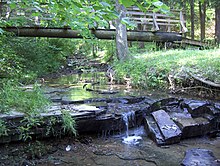Nature reserve: Difference between revisions
GrahamBould (talk | contribs) mNo edit summary |
GrahamBould (talk | contribs) m Links |
||
| Line 7: | Line 7: | ||
In the [[USA]] the [[United States Fish and Wildlife Service]] is responsible for managing many nature reserves including [[National Wildlife Refuge]]s. State and local governments administer others and some belong to private trusts. |
In the [[USA]] the [[United States Fish and Wildlife Service]] is responsible for managing many nature reserves including [[National Wildlife Refuge]]s. State and local governments administer others and some belong to private trusts. |
||
The first country in the world to have a nature reserve (a wildlife sanctuary) was [[Sri Lanka]], in the [[3rd century BC]]. However, dating back to antiquity there are various cultural practices that equate roughly to the establishment and maintaining of reserved areas for biota including fish, waterfowl and other animals. These would often have a religious underpinning - for example the 'evil forest' areas of West Africa were forbidden to humans, who were threatened with spiritual attack if they went there. Sacred areas taboo from human entry or fishing are known from many ancient cultures worldwide.[http://www.slwcs.org/]. In the modern era the first major nature reserve was Yellowstone Park, followed by the Royal National Park near Sydney, Australia. |
The first country in the world to have a nature reserve (a wildlife sanctuary) was [[Sri Lanka]], in the [[3rd century BC]]. However, dating back to antiquity there are various cultural practices that equate roughly to the establishment and maintaining of reserved areas for biota including fish, waterfowl and other animals. These would often have a religious underpinning - for example the 'evil forest' areas of West Africa were forbidden to humans, who were threatened with spiritual attack if they went there. Sacred areas taboo from human entry or fishing are known from many ancient cultures worldwide.[http://www.slwcs.org/]. In the modern era the first major nature reserve was [[Yellowstone National Park]], followed by the [[Royal National Park]] near Sydney, Australia. |
||
== See also == |
== See also == |
||
Revision as of 10:17, 4 November 2006

A nature reserve (natural reserve, nature preserve, natural preserve) is a protected area of importance for wildlife, flora, fauna or features of geological or other special interest, which is reserved and managed for conservation and to provide special opportunities for study or research. Nature reserves may be designated by government institutions in some countries, such as the United Kingdom, or by private landowners, such as charities and research institutions, regardless of nationality. Nature reserves fall into different IUCN categories depending on the level of protection afforded by local laws.
At the end of March 2004, there were 215 NNRs (National Nature Reserves) in England with a total area of 879 square kilometres. The Reserves are scattered through England, from Lindisfarne in Northumberland to The Lizard in Cornwall. Nearly every rural county has at least one. Derbyshire Dales NNR lies within the Peak District National Park. The reserve consists of five separate limestone valleys Lathkill, Cressbrook, Monk's, Long and Hay. These five dales represent some of the best examples of wildlife and geology in the White Peak. Many NNRs contain nationally important populations of rare flowers, ferns and mosses, butterflies and other insects, and nesting and wintering birds. Examples include unique alpine plants at Upper Teesdale and the beautiful field of fritillary lilies at North Meadow Cricklade, Wiltshire.
In New Zealand a number of separate distinctions are made for the term nature reserves. Wilderness areas, National Parks, scenic reserves, scientific reserves and forest parks are all types of nature reserves with varying degrees of protection. A comparatively new concept in wildlife preservation, pioneered in New Zealand, is the Ecological Island.
In the USA the United States Fish and Wildlife Service is responsible for managing many nature reserves including National Wildlife Refuges. State and local governments administer others and some belong to private trusts.
The first country in the world to have a nature reserve (a wildlife sanctuary) was Sri Lanka, in the 3rd century BC. However, dating back to antiquity there are various cultural practices that equate roughly to the establishment and maintaining of reserved areas for biota including fish, waterfowl and other animals. These would often have a religious underpinning - for example the 'evil forest' areas of West Africa were forbidden to humans, who were threatened with spiritual attack if they went there. Sacred areas taboo from human entry or fishing are known from many ancient cultures worldwide.[1]. In the modern era the first major nature reserve was Yellowstone National Park, followed by the Royal National Park near Sydney, Australia.
See also
- Biodiversity
- Biosphere Reserve
- Conservation designation
- Country park
- Local Nature Reserve
- Marine park
- National park
- Pocket park
- Protected area
- Royal Society for the Protection of Birds reserves (UK)
- Special Protection Area
- The Nature Conservancy
- Wildlife corridor
- Wildlife refuge
References
